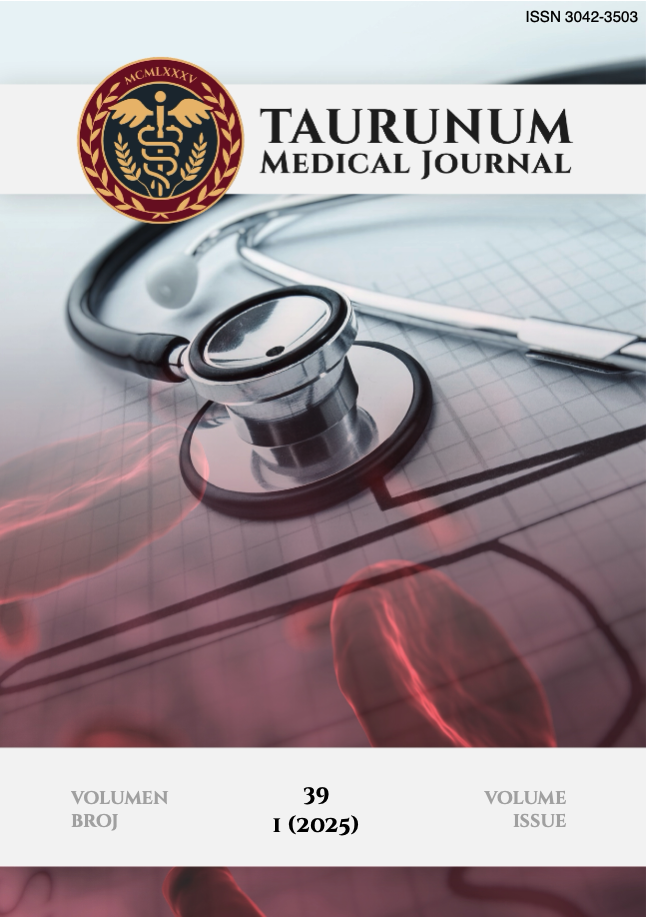Current issue

Volume 39, Issue 1, 2025
Online ISSN: 3042-3511
ISSN: 3042-3503
Volume 39 , Issue 1, (2025)
Published: 31.03.2025.
Open Access
Welcome to Issue 39, No. 1 – the first of our two annual publications for this year. Inside, you'll find a curated selection of articles. Start your year with the essential knowledge and perspectives offered in this timely edition
All issues
Contents
31.03.2025.
Original Article
Challenges in the Diagnosis and Treatment of Small Bowel Bleeding: The Role of Predictive Scores in Clinical Decision-Making
Introduction: Gastrointestinal bleeding represents a serious clinical challenge due to the complexity of diagnosis and the therapeutic options required for effective management. Small bowel bleeding, although relatively rare, poses a significant diagnostic dilemma due to the difficulty in identifying the source and the variability of causes, which differ depending on the patient's age. In the elderly population, vascular malformations are the most common causes, whereas in younger patients, the etiology can be broader, including inflammatory diseases, tumors, and congenital abnormalities. The aim of this study was to investigate the clinical characteristics and outcomes of patients with hemodynamic instability due to small bowel bleeding, with a particular focus on the application of predictive scores (GBS and CRS). Materials and Methods: This retrospective observational study, conducted from January 2023 to January 2024, included 24 hemodynamically unstable patients with diagnosed small bowel bleeding. All patients were assessed using the Glasgow Blatchford Score (GBS) and Clinical Rockall Score (CRS) to evaluate risk and predict clinical outcomes. Demographic data, clinical and diagnostic information were analyzed, with comparative analyses of preoperative, intraoperative, and histopathological findings. Results: The mean age of the patients was 69.8 years, and 79.2% presented with hematochezia. All patients had GBS > 15 and CRS > 6. Conservative treatment was effective in 62.5% of patients, while 37.5% required surgical intervention. The mortality rate was 12.5%. Statistically significant positive correlations were found between GBS and mortality (r = +0.76, p < 0.05) and between GBS and surgical intervention (r = +0.32, p < 0.05). The most common causes of bleeding were vascular lesions, although the source of bleeding was unidentified in 11 patients. Conclusion: Small bowel bleeding remains a major challenge for clinicians, requiring a multidisciplinary approach to diagnosis and treatment. The use of predictive scores such as GBS and CRS aids in assessing severity, guiding decision-making, and planning further treatment.
Nemanja Trifunović, Nebojša Mitrović, Dejan Stevanović, Damir Jašarović, Goran Aleksandrić, Marija Nikolić, Sara Filipović, Jovana Trifunović
31.03.2025.
Review Article
Adenocarcinoma of the esophagogastric junction presented as a vegetative tumor in the hiatal hernia sac
Introduction: The incidence of esophageal and esophagogastric junction adenocarcinomas has been increasing in developed countries, with primary risk factors including gastroesophageal reflux disease (GERD), smoking, and obesity. Chronic GERD can lead to Barrett’s esophagus (BE), a premalignant condition that elevates the risk for esophageal adenocarcinoma. Case Report: We present a case of a 63-year-old woman with nausea and epigastric pain. Her history was notable for Sjögren’s syndrome and a positive family history of prostate cancer, without smoking or alcohol use. Endoscopy revealed a distal hiatal hernia and long-segment Barrett’s esophagus (LSBE) with a 3 cm ulcerated lesion at the gastroesophageal junction, located within the hernia sac. Biopsies confirmed well-differentiated adenocarcinoma in LSBE. CT imaging showed a tumor extending through the hiatal hernia with distal esophageal wall thickening and lymph node metastases but no distant metastases. The patient underwent a subtotal esophagectomy with lymphadenectomy and esophagogastric anastomosis using the Ivor Lewis procedure. Pathology confirmed adenocarcinoma with lymph node metastasis and a close circumferential resection margin. Six cycles of postoperative chemotherapy with platinum and fluoropyrimidine were administered. The patient was recurrence-free at a three-year follow-up. Conclusion: This case underscores the association between hiatal hernia, Barrett's esophagus, and esophageal adenocarcinoma, particularly in the setting of disrupted antireflux mechanisms. The findings support the importance of early investigation and monitoring in patients with GERD and BE to mitigate cancer progression.
Aleksandar Pavlović, Sara Filipović, Jovana Trifunović, Nemanja Trifunović, Miroslav Kreačić
31.03.2025.
Review Article
The Importance of Intraoperative Exploration and Intensive Postoperative Monitoring in the Detection and Management of Synchronous and Metachronous Colorectal Tumors
Introduction: Colorectal cancer (CRC) is among the most common malignancies, with a rising global incidence. Synchronous tumors refer to the presence of multiple tumors simultaneously in different segments of the colon or rectum, while metachronous tumors occur during follow-up after initial treatment. These tumors are often undetected during standard diagnostic procedures, making intraoperative exploration and postoperative monitoring crucial for timely diagnosis and successful treatment. Case Report: A 63-year-old patient was admitted for sideropenic anemia and weight loss. Colonoscopy revealed a tumor in the cecum, confirmed as adenocarcinoma. During surgery, two additional tumor lesions were discovered in the ascending and transverse colon. Following an extended right hemicolectomy and adjuvant chemotherapy according to the FOLFOX protocol, the patient remained disease-free until May 2023, when a metachronous tumor in the rectum was detected. The lesion was removed via transanal excision, and histopathological findings indicated intramucosal carcinoma. Continuous follow-up until November 2024 showed no disease progression. Conclusion: Intraoperative exploration enabled the identification of previously undetected synchronous tumors, influencing the extent of surgery and the postoperative treatment plan. Regular monitoring, including colonoscopy and radiological methods, is essential for the early detection of metachronous tumors and achieving optimal outcomes. This case highlights the importance of a multidisciplinary approach in managing patients with synchronous and metachronous CRC.
Marija Nikolić, Nebojša Mitrović, Dejan Stevanović, Nemanja Trifunović, Jovana Trifunović, Milica Radivojević, Damir Jašarović



